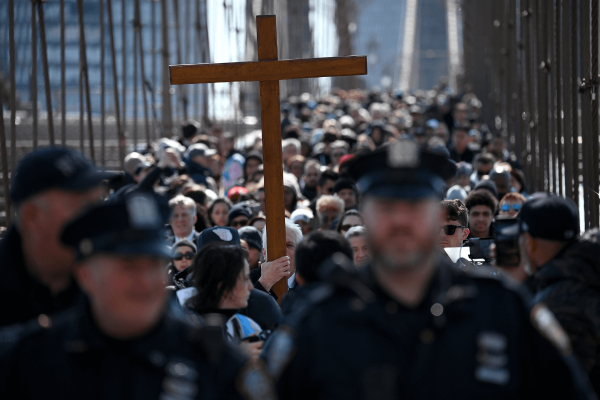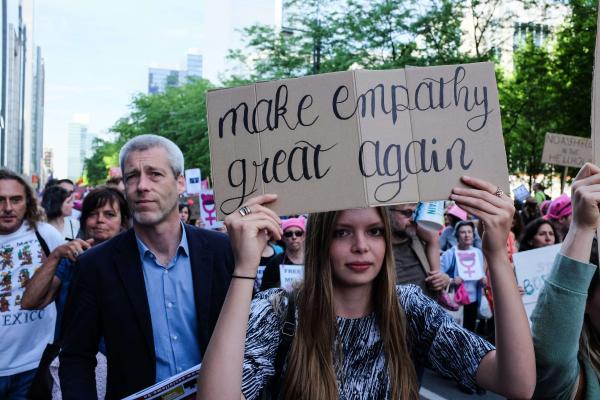“This is not normal.”
That phrase has fluttered around social media just about any time Donald Trump has tweeted or made a speech during his first year in office. And, just as reliably, observers have raised concerns about the “normalization” of Trump — and the white supremacist, white nationalist, and “alt-right” movements who continue to be emboldened by his election — by various media outlets.
Yet as insidious as far-right movements and individuals are, and as important as it is to learn about their activities, another kind of normalization is going on in media around the subtle, everyday racism among white Americans which also led to Trump’s election as president.
Religion reporting and writing is not immune from these dangers. Writers within my own Roman Catholic tradition seem particularly prone to normalize racism by downplaying or dismissing it as a very significant factor in the election. Some commentators at Crux, a mainstream Catholic site which aims to include “different voices… without the deck being stacked against anyone in advance,” have shown a troubling tolerance, and even celebration, of Catholic Trumpism: Since the election, we have read from Thomas D. Williams that President Trump and Pope Francis share a similar “passion for the peripheries.” Michel Therrien argues that responding to Trumpism with a preferential option for people of color is a liberal distortion of the gospel. Kathryn Lopez says Trump's victory should make Catholics hopeful, and that, despite his faults, Steve Bannon can be a “fun” guy to hang out with.
Liberal Catholics have also joined the “calm down” chorus. Popular columnist at National Catholic Reporter Phyllis Zagano advised readers to “tone down the anger,” because Trump’s victory isn’t the end of the world. Others, including Fr. Thomas Reese, joined secular counterparts by explaining Trump’s victory as the understandable result of an angry “white working class” hungry mostly for economic change, rather than racial revenge — a view which ignores both Trump’s popularity among white elites and the way racism is intertwined with class consciousness in, say, places like Appalachia, where I come from.
A year later, not much has changed. Already in 2018, several Catholic writers have continued a denial of widespread racism among white Catholic Trump supporters. National Catholic Reporter’s Michael Sean Winters recently made one of his characteristic jabs at “the left,” this time for its “lazy,” “silly,” and “utterly predictable” insistence that Trump’s white Christian base has been motivated by, and further encouraged in, its racism. After a year of continual reports of rising hate-motivated violence, Winters argues that it is “repulsive” to connect racism with support for Trump. (That Winters contrasts the analysis of a “sophisticated” white writer from The Atlantic with that of a “lazy” and “repulsive” black writer from The Root in making his case plays on racial stereotypes, and seems to enact the very racism he wants to deny.)
And in November, Jesuit Fr. Jim McDermott published “Meet these Catholics who voted for Trump and love Pope Francis” for America Magazine, a U.S. Jesuit publication among my most-read periodicals. As the title suggests, the article is a sympathetic portrait. McDermott connected with a number of people who feel “attacked” by other Catholics for the way they voted.
These Catholic Trump voters use racialized language nearly identical to secular voters: One says “[W]hatever he says, he might say it the wrong way, but it resonates with me.” Though she praises Pope Francis’ “inclusivity,” she also supports Trump’s proposal to build a wall along the southern border of the United States: “I don’t believe you can just walk across the border … if you believe that, you should go to England and see what’s happening there with open immigration.” Another appreciates that Trump “shakes things up” by being “not politically correct a lot of the time.” Still another affirms Trump’s wall, but insists Trump is “obviously not a racist.”
In an email to me, McDermott explained why he wrote the article this way:
I think painting every Trump voter with the same brush is a problem. It’s not accurate, and it’s usually just a rhetorical maneuver meant to undermine and demonize. My article was meant instead to invite [readers] to meet actual people, and in so doing humanize and complicate some of the prevailing narratives.
Fair enough. There is certainly value in religious publications profiling people of faith who voted for Trump. But there is a real danger in doing it in this particular way: at no point offering any challenge to the racism in the views these white Catholic Trump supporters express, and at no point indicating that all of the Trump voters interviewed are white (McDermott confirmed for me that this was the case in his story).
In fact, Catholic writers often deliberately cast Trump Catholics in a positive way. McDermott repeatedly reminds us, for example, that they do not find their attraction to Trump and Francis contradictory and provide an “interesting bridge” between differing worldviews. Elsewhere, McDermott goes further: Trump voters are doing something analogous to “breaking open the Word” — as in the Word of God — and creating “new ways forward” so that there “might actually be some movement on these issues.”
Part of the intent behind humanizing white religious Trump supporters seems to be to present evidence that they are in fact good people. And they no doubt are in some ways. But it should be obvious that people who are otherwise “good” — even those who love the pope! — are also able to be racist, intentionally or not.
Religion writers have a duty to reveal through their work that racism is not always overt or intentional. Racism is, in the words of theologian Fr. Bryan Massingale in a recent article also published in America, a “sickness of the soul” rooted in an unexamined lack of empathy for people who are not white. According to Massingale, we will never end racism if we do not know what it is.
The question hinges on how these stories are written and what purpose they serve. When religion writers don’t get this right, they run the risk of reversing the empathy that white people of faith might feel for persons and communities of color. By allowing white Catholic Trump-supporting interviewees to be the sole and explicit recipients of the reader’s empathy, these writers fail to create room for those who suffer as a result of the interviewees' views or actions. People who vote for a racist may deserve empathy only for the tragedy of their rationalizations for having done so.
We must also be honest about the U.S. Catholic Church’s record when it comes to racism, with a hierarchy that has largely ignored racism both in society and in the church for most of its history, and a Catholic intellectual community that has not done much better.
Fr. Massingale wrote in his book Racial Justice and the Catholic Church, “The most notable fact concerning the Catholic theological contribution to racial reconciliation is its absence.” By ignoring racism within the church, church leaders and mainstream religion writers have been complicit in the rise of the far right views that we see on full display today. With this history in view, white Trump Catholics can indeed be seen as victims, but they are victims of a church that has failed to prophetically name the sin of racism for what it is.
Jesuit priest James Martin recently named the traditionalist Catholics who take it upon themselves to be the church’s heresy police as “a kind of Catholic alt-right.” Fr. Martin’s quip is an apt metaphor for the issues he has had to deal with, but the real Catholic alt-right has been visible now for some time, including more than the obvious white supremacists like Steve Bannon, Islamophobes like Robert Spencer and Jesuit Fr. Mitch Pacwa, and explicit alt-right Catholic websites. It also arguably includes a Eurocentric papacy under Benedict XVI, which presumed the superiority of Western culture even into the 21st century, and a U.S. hierarchy which has repeatedly allied itself with white Christian racist politicians.
Good intentions aside, religion writers and publications can, and must, do better in how we cover the phenomenon of Trumper Catholicism. Those that try to stake out a “centrist” approach to racism, xenophobia, or white supremacy have become largely unhelpful to Catholics who want more analysis and truth-telling. As a result, we tend to gravitate toward the deeper analysis and stronger prophetic approaches of non-Catholic religious publications, or of secular publications that cover religion but are not constrained by the intra-ecclesial baggage of a racist white hierarchy and the white theological and media appendages that largely follow suit.
Back in September, America rightly called on Catholics to “fight racism at every turn.” Yet Catholic media has yet to really give a good example of how to do that when it comes to reporting on Catholic Trump supporters. Normalizing racism as just another set of opinions that “good people of faith” might have — whether extremists like Steve Bannon or the “normal” Catholic in the pew next to us — isn’t the way to do it. Religion writers, like everyone in media, have a special responsibility: to fight racism at every turn of the page.
Got something to say about what you're reading? We value your feedback!






